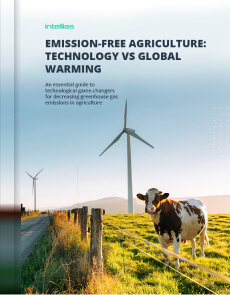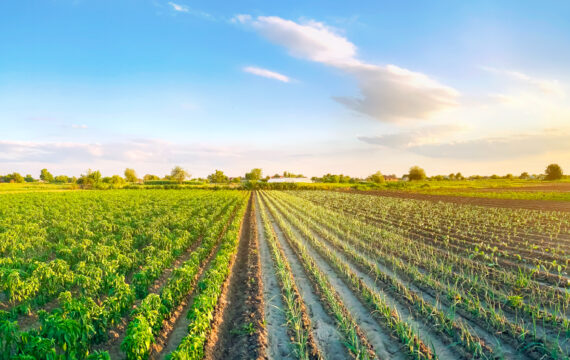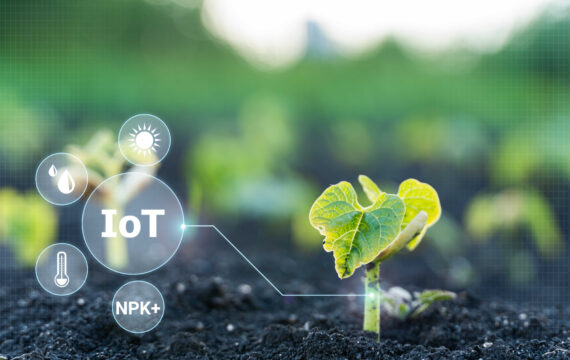If you could build a time machine, would you rather travel back in time to make changes in the past or take a sneak peek into the future to foresee possible outcomes? Digital twins in agriculture let you do both. They’re virtual time machines, providing insights on critical assets and operations at specific points in your farm’s past, present, and future.
Introducing digital twins to agriculture is rapidly moving from concept to reality, with digital twin technology making its way to fields and barns. In doing so, it is transforming the day-to-day operations of agribusinesses, affecting how they manage their processes, systems, and facilities. On a global scale, this new technology is becoming the driving force for a sustainable future, removing uncertainties in crop cultivation, livestock farming, and climate change impacts.
Let’s explore what digital twins are, their top benefits, diverse use cases, and how digital twinning is enabling efficient, safe, and sustainable smart farming.
What are digital twins and how do they work?
Digital twins debuted in 2010 when NASA built a complete virtual replica of their spacecraft that changed in sync with its physical twin. Today, digital twinning is among the hottest emerging technologies and is reshaping entire industries, bringing together the physical and virtual worlds to uncover insights and actions that drive immense business value.
Demand for digital twin solutions in manufacturing is rising sharply, and the global digital twins market is expected to exceed $73.5 billion by 2027.
A digital twin is an accurate virtual representation of a physical object in a digital environment that is used to remotely monitor the physical object’s performance around the clock, collect and analyze data, simulate real-world scenarios and their outcomes, make data-powered decisions, and provide corrective recommendations if necessary.
Powered by the latest innovations in IoT technology, cloud computing, and artificial intelligence, digital twins capture massive amounts of data from environmental sensors and convert that data into insights with the help of a cloud-based processing model. Through a digital twin interface, users can view information on an object’s present condition, history, or predicted future.
Digital twin technology is a two-way street: data flows back and forth between a physical object and its digital double. If there’s a change in the actual asset, this change is mirrored in the digital twin. Conversely, changes made to the digital twin can be implemented in the real world.
Data interaction between the physical object and its digital representation in a digital twin

Source: MDPI
The role of digital twins in agriculture
In agriculture, digital twin technology allows farmers to create a digital model of an entire agricultural ecosystem, including fields, facilities, crops, animals, and machinery. Digital counterparts of farm assets can be used to track the health of soil, crops, or livestock, analyze farm operations, act on real-time insights, and predict future outcomes.
With environmental concerns and the challenge of growing enough food to feed an increasing number of people, farmers are under pressure to enhance yield efficiency and food quality, minimize the cost of maintenance and logistics, ensure farm sustainability, and mitigate unpredictable risks like extreme weather or crop diseases. Applying digital twins in agriculture sector holds tremendous promise to address these challenges.
For a digital twin to serve as a precise counterpart for a real-world object, it requires sufficient data. Digital twins rely on pervasive real-time data collection from various sources, including satellites, drones, embedded sensors, and RFID tags, as well as historical information on soil management, planned crops, and weather patterns.
By analyzing consolidated data from a single digital twin platform, farmers can foresee potential deviations, simulate effects of interventions, and effectively respond to possible issues (or prevent them altogether). All these measures can be taken remotely, without the need for immediate on-site examination.
With digital twins, you get a continuous monitoring and reporting system that alerts you of pest-affected plants, a cow’s poor health, an equipment malfunction, soil dryness, or a temperature drop. Digital twins are also a powerful simulation and prediction tool to envision the impact of farming practices and the forces of nature on your business and prepare for possible scenarios.
Digital twins in farming: From field to screen to harvest
Adopting digital twin technology can empower farmers with unparalleled insights and foresight into their fields, provided it’s implemented effectively. Here’s a stepwise approach to embracing the transformative impact of digital twins in farming:
Real-time data collection
Data gathered from in-field sensors, remote sensing systems, soil probes, weather forecasts, and other sources can provide live insights into critical variables such as humidity, pH level, temperature, nutrients, pest infestation, soil depletion, and weather impacts.
For data to be precise and reliable, sensors and data sources should be regularly calibrated. This will ensure the accuracy of a digital twin’s forecasts and suggestions.
Building a digital duplicate
Using digital twin software, farm operators can create a virtual replica of a field that reflects its characteristics, including field size and shape, topography, soil types, microclimate, sunlight exposure, planting patterns, drainage, and cultivation history. The software must be compatible with the data sources to seamlessly integrate data and provide accurate results.
Data integration
Amassed data is filtered to ensure only relevant data is integrated into the digital twin model, where algorithms analyze and interpret it. This data integration strategy allows for a holistic view of a field’s status to evaluate the interplay of diverse factors and their impact on crop vitality and yields.
Observation and analysis
Digital twins create a real-time reflection of a field’s current state, helping farmers closely monitor crops, soil, and weather to understand plant growth patterns, evaluate resource needs, and react to crop diseases. Early detection of possible disruptions enables timely corrective measures, reduces risks, and enhances crop health and farm productivity.

Prediction and simulation
Predictive capabilities of digital twin technology powered by artificial intelligence and machine learning help farmers mitigate the risk of crop failure by detecting issues in advance, conducting preventive equipment maintenance, and providing instant solutions. Digital twins are also helpful in forecasting weather patterns and understanding the long-term consequences of climate change.
A crop model can simulate how a plant would grow in different conditions and scenarios based on soil, nutrient, and weather data. Soil simulations replicate properties of specific soil types, assisting in optimizing nutrient and water management. Simulations allow farmers to predict growth patterns, experiment, and fine-tune their farming strategies without environmental or financial risks.
Optimization and decision-making
Real-time insights from a virtual farm can guide data-driven decisions. Based on these insights, farmers can adjust crop rotation, planting dates, irrigation, fertilization, and pest control, manage their resources more efficiently, and optimize logistics and supply chains. This leads to improved yields, cost savings, and optimized resource use, ensuring environmentally sustainable operations.
Unlocking the value of digital twins for agriculture: Benefits and use cases
Digital twin technology is revolutionizing the agricultural industry and redefining traditional farming practices on many levels and in many areas. The following are key applications of digital twins in agriculture, highlighting the benefits of integrating twinning into your farm ecosystem.
Field management
Well-timed decisions help growers transform their farms into sustainable agribusinesses. Digital twins offer nuanced insights into crop, soil, and environmental conditions, guiding informed choices regarding irrigation, fertilization, and pest control. As a result, crops get exactly what they need when they need it, ultimately leading to enhanced yields.
When used for field monitoring, digital twins allow farmers to improve crop management with prompt tweaks based on real-time data, resulting in more accurate yield predictions. What’s more, digital twins can streamline resource use, ensuring water, fertilizers, and other inputs are used efficiently while minimizing waste and ensuring sustainable crop growth.
Indoor and precision farming
In controlled growing environments, digital twin technology serves as an essential precision farming tool for producers. Farmers can monitor environmental conditions, track crop growth, and adjust farming activities to create the most favorable crop conditions.
Applying digital twins in indoor farming enables optimized use of energy, water, and nutrients, trimming resource waste and operational costs. High efficiency in managing indoor farms ensures improved yields, fostering sustainable high-output farming in controlled environments.
Farm machinery maintenance
Replicating AgriTech machinery allows farmers to monitor the condition and work of equipment in real time to detect inefficiencies and prevent failures. Using information on equipment performance, you can take immediate action to resolve issues, optimize machinery use, and adjust maintenance schedules, minimizing downtime and avoiding disruptions to farming operations.
Weather prediction and climate risk mitigation
Integrating real-time and historical data into an advanced digital twin weather model enables simulations of weather conditions and climate variations. With a digital twin climate emulator, farmers can predict a crop’s response to weather hazards and adjust their practices to manage weather-related risks proactively and strengthen crop resilience.
Accurate weather forecasts generated by predictive models help farmers optimize water use and conserve water resources, aligning irrigation with predicted rainfall. Planning agricultural activities around weather predictions ensures optimal farming schedules, maximizing yields and minimizing losses.

Supply chain and logistics
Digital twin technology makes supply chain and logistics operations more efficient and traceable. Farm operators can chart each stage of the agricultural supply chain – from production to delivery – ensuring products make it to their destinations on time and in good condition.
Incorporating digital twins into supply chains and logistics allows farmers to lower costs by optimizing delivery routes and efficiently handling delays. Digital twins improve supply chain visibility, enabling real-time monitoring of product movements and conditions. This efficiency and transparency results in a shorter time to market, timely delivery of fresh products, and compliance with rigorous market standards.
Sustainability and resource optimization
Digital twin technology in agriculture promotes eco-friendly farming practices, helping farmers reduce their environmental footprint and fostering conservation of natural resources and biodiversity. Digital twins equip farmers with real-time insights that guide sustainable decisions on the use of energy, water, and fertilizers, curbing waste and minimizing environmental impacts.
Using a digital replica, you can track deviations in carbon levels, biodiversity, pollinator activity, and water catchment as well as identify whether these changes result from human impact. Furthermore, digital twin technology enhances resource management, ensuring optimized resource allocation and improving a farm’s overall efficiency and sustainability.
Farm innovation and advancement
Digital twins are unleashing new R&D capabilities in agriculture, allowing for simulations of farming processes and experimentation with various scenarios. In a way, a digital twin acts as a virtual sandbox for testing new agricultural practices and technologies and developing effective solutions.
With digital twins, you can explore and validate new concepts in a risk-free environment before implementing them in practice. By accelerating agricultural research and development, digital twin technology ushers innovation into the agricultural industry while significantly cutting the time needed to bring new concepts to life.
Financial analytics for maximized profitability
Digital twins are reshaping the economics of agriculture by analyzing financial data to optimize profits. The technology provides in-depth financial analytics, helping agribusinesses make insight-led decisions on operations, investments, and resource allocation.
Financial analytics provided by digital twins unveil financially rewarding strategies and opportunities, empowering secure and data-driven investment choices. Armed with profound financial insights, farmers can channel their resources towards the most lucrative and promising ventures and refine operational decisions based on cost–benefit analysis.
Livestock farming
Digital twins in farming are transforming livestock management, providing a proactive approach to animal well-being. Sensors installed in barns or at feeding and milking stations collect data on animals’ health, behavior, and nutrition. By building digital replicas for each animal, farmers gain live insights into the health of their livestock.
A digital twin can help farmers detect health issues in animals at early stages, create simulations to intervene promptly with the right treatment, and prevent diseases from spreading within the herd. Insights from digital twins can enhance the efficiency of milk or meat production and assist in designing barn systems for optimal air quality and temperature control.
Digital twins in livestock farming

Source: MDPI
Meet Intellias Digital Twin: A digital twin accelerator to empower sustainable and resilient ecosystem management
Deploying a digital twin for your farm requires the right combination of agriculture expertise, IoT and cloud competence, and experience in artificial intelligence. Not every agricultural enterprise has access to this blend of tech expertise, to say nothing of smaller agribusinesses.
Having built successful digital twin solutions, Intellias came up with the idea to engineer Intellias Digital Twin, a cloud-native, scalable, and customizable digital twin software platform enabling modeling of visual 3D twins in the cloud. Intellias Digital Twin has been designed to help organizations create safe, functional, and optimized infrastructure with sustainability and efficiency at its core.
Data integration and visualization
The Intellias Digital Twin platform collects meaningful data from sensors, connected devices, and security systems to enhance algorithm performance. The platform seamlessly integrates data from any type of IoT device and is compatible with all modern connectivity standards.
Intellias Digital Twin uses Intel SceneScape technology, a multimodal scene intelligence software framework enhanced by vision-based AI algorithms. Intel’s technology transforms sensor data and camera images to make live updates to a 4D digital twin that is used to view past analytics, keep tabs on what’s happening in the present, and make predictions for the future.
Offering powerful visibility and transparency, Intellias Digital Twin allows operations managers to quickly spot bottlenecks and critical issues and remotely manage devices, assets, and energy supplies to improve performance and resource efficiency.
Scenario simulation and ecosystem optimization
Intellias Digital Twin enables AI-driven simulations of what if performance scenarios using real-world data. Based on the low-code/no-code principle, multiple targeted scenarios are run to conduct experiments related to energy consumption, use of facility space, environmental footprints, and more.
AI algorithms within Intellias Digital Twin combine situational awareness from sensors with input from operations managers, suggest simulation parameters to achieve improvements, and execute new scenarios for a given facility.

For example, say a facility manager needs to lower power consumption by 10%. An AI model suggests bringing together operations and activities in a smaller space to optimize electricity use. If that scenario doesn’t seem workable for the manager, the AI comes up with another simulated scenario for a potential energy-saving solution.
Or let’s say a farmer considers increasing fertilizer volumes on a field to enhance the yield. An AI algorithm can assess the environmental impact of this move, reveal deficiencies in soil moisture levels, and suggest an efficient irrigation strategy that results in sufficient crop growth with more sustainable practices.
We’ve recently shared our Intellias Digital Twin journey, explaining why twinning is winning and how the Intellias Digital Twin platform accelerates digital twin adoption for businesses. Up next is a compelling example of how Intellias reinforces efficient and sustainable agricultural practices with digital twin technology.
Grand Farm Data Hub: Harnessing agriculture’s data potential
Collecting data from multiple data points – from soil sensors to satellite imagery – results in terabytes of data for just one field. In an effort to integrate and manage extensive amounts of data from diverse sources, agricultural innovators are facing the challenge of data silos: isolated data stores that are difficult to combine and use for effective decision-making.
Siloed data results in a lack of understanding of current operational processes and leads to low farm performance and significant business risks. The agricultural community needs access to consolidated data in a single platform to be able to use this data for training models. This platform, however, needs to consider the unique characteristics of each farm and field.
The need to break down data silos prompted Grand Farm – a network of growers and technologists aiming to accelerate agricultural innovation – to launch Grand Farm Data Hub. This open-source data storage platform is designed to allow farmers and agricultural players to find, accumulate, centralize, and generate agricultural data.
Data Hub is developed through a collaborative partnership between Intellias and Grand Farm. We’re focusing on an AI-first approach in building the architecture, with digital twins and AI as core functionalities. Another important aspect of our work is ensuring interoperability and compliance with data security standards.
Data Hub allows users to create digital twins of farms using aggregated data sources and tap into vast datasets suitable for research, automation, and simulation. With access to consolidated agricultural data, publicly available algorithms, and advanced analytics, agribusinesses can generate data-driven decisions about sowing, watering, pest management, and harvesting, leading to streamlined processes and higher profits.
Together, Grand Farm and Intellias are fostering growth and innovation in the industry, accelerating sustainable digitalization of farms and agricultural enterprises with Data Hub.
From the past, across the present, and into the greener future of your farm with a digital twin time machine
The era when agriculture depended solely on a farmer’s watchful eye, physical strength, and oxen is long gone. With fields studded with IoT sensors and farms equipped with farm management systems, a farmer can keep an eye on a digital twin that offers a dynamic picture of the past, present, and future of the entire farm ecosystem.
In the world of software intelligence and advancements in machine learning, adoption of digital twins in agriculture is becoming inevitable. Digital twins fuel the synergy between nature and technology, guiding agriculture into a greener and more productive future.
Analyzing historical data, capturing and acting on the farm’s here-and-now insights, and making accurate projections for the future – this is the digital twin time machine in action, propelling farming into a new era of sustainable profitability.
Intellias fosters long-term sustainability in farming with transformative AgriTech solutions. If you’re seeking to harness the power of digital twins for your business, contact us today!





